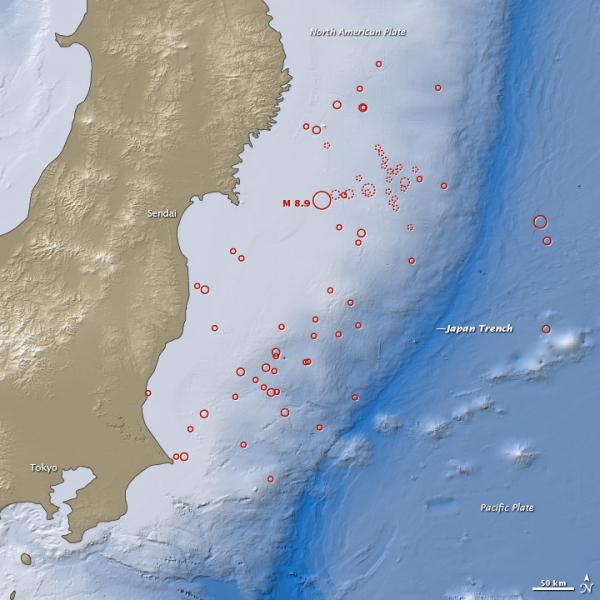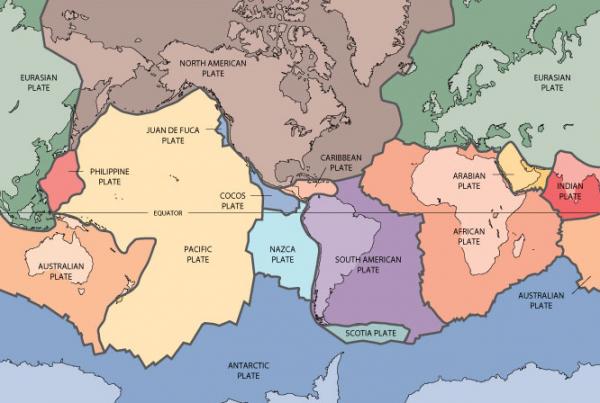Japan's Explosive Geology Explained


When it comes to building a country, you'd be hard-pressed to do it in a more volatile part of the world than Japan.
About 1,500 earthquakes strike the island nation every year. Minor tremors occur on a nearly daily basis. Deadly quakes are a tragic part of the nation's past.
The anniversary of the Great Kanto Earthquake of 1923, for example, which killed more than 100,000 people around Tokyo, is now national Disaster Prevention Day. More recently, a 6.8 magnitude earthquake struck the city of Kobe in 1995, killing more than 6,000 people.
Japan has such a large potential for earthquakes and disaster because the nation sits atop four huge slabs of the Earth's crust, called tectonic plates. These plates mash and grind together and trigger deadly earthquakes, like the 8.9-magnitude quake that struck on Friday (March 11). [Photos: Japan Earthquake and Tsunami in Pictures]
The tectonic activity has also created explosive volcanoes, like south Japan's Mount Kirishima, which continued its recent eruptive streak today (March 14).
Japan lies along the Pacific Ring of Fire a narrow zone around the Pacific Ocean where a large chunk of Earth's earthquakes and volcanic eruptions occur. Roughly 90 percent of all the world's earthquakes and 80 percent of the largest ones strike along the Ring of Fire.
Great quake
Get the world’s most fascinating discoveries delivered straight to your inbox.
Friday's quake off the east coast of Honshu, Japan's largest island, was the fifth-largest ever recorded, according to the U.S. Geological Survey (USGS), and the largest ever recorded in Japan.
More than 150 aftershocks of magnitude 5 or greater have followed including more than two dozen of magnitude 6 or greater. The number of aftershocks in Japan is not uncommon for an earthquake of this size, said geologist Eric Geist, of the USGS, at a news conference last week, and the rumbling could last for a year or more.
As a rule of thumb, an earthquake's largest aftershock is about one magnitude lower than the mainshock, said Paul Caruso, a geophysicist with the USGS. The largest aftershock from this earthquake has been a magnitude 7.1.
Japan's tectonic shuffle
Earthquakes typically occur along faults, which are breaks in the rocky plates of the Earth's crust. These faults accumulate strain over the years as two plates butt heads.
Japan's stretch of the Ring of Fire is where the North American, Pacific, Eurasian and Philippine plates come together. Northern Japan is largely on top of the western tip of the North American plate. Southern Japan sits mostly above the Eurasian plate.
Friday's temblor struck 231 miles (373 kilometers) northeast of Tokyo and 80 miles (130 km) east of Sendai, Honshu, in the Pacific Ocean near the Japan Trench. The Japan Trench, a subduction zone, is where the Pacific plate beneath the Pacific Ocean dives underneath North American plate beneath Japan. This violent movement, called thrust faulting, forced the North American plate upward in this latest quake.
On average, the Pacific Plate is moving west at about 3.5 inches (8.9 centimeters) per year, and the movement has produced major earthquakes in the past nine earthquakes of magnitude 7 or greater since 1973. The largest of these was a magnitude 7.8 earthquake in December 1994, which caused three fatalities and almost 700 injuries, approximately 160 miles (260 km) to the north of Friday's quake. In June of 1978, a magnitude 7.7 earthquake about 22 miles (35 km) to the southwest caused 22 fatalities and over 400 injuries.
Earthquake aftermath
The rupture during Friday's quake was almost 200 miles (322 km) long, on an underwater fault that is about 220 miles (354 km) long by about 60 miles (97 km) wide, said Tom Broker, of the USGS. Earthquakes along that fault can affect the rest of the world literally.
"This is just a ginormous earthquake," Broker said. "It's really hard to grasp how big it is."
For one, the intense temblor accelerated Earth's spin, shortening the length of the 24-hour day by 1.8 microseconds, according to geophysicist Richard Gross at NASA's Jet Propulsion Laboratory in Pasadena, Calif.
Japan's Earthquake Research Committee said the earthquake forced the North American plate eastward by about 66 feet (20 meters), reported Japan's national broadcast agency, NHK. The entire island of Honshu was moved about 8 feet (2.4 m) east, according to USGS scientists. Geologists in St. Louis reported that their city moved up and down a fraction of an inch during the quake, but too slowly for anyone to notice, reported the St. Louis Post-Dispatch.
Tsunami trigger
Friday's huge earthquake was about 15.2 miles (24.4 km) deep, which was shallow enough to trigger a tsunami as the seafloor was pushed up and away from Japan. As the energy from the quake rose, two waves were created. Wave heights of more than 20 feet (6 m) socked Japan's coast, where the death toll is expected to exceed 10,000, according to news reports.
At the same time, a tsunami roared across the Pacific Ocean at the ground-speed of an airplane, said Ken Hudnut of the USGS. Damage was reported in Hawaii and near the California-Oregon border.
{youtube rzqMljEPdd8}
Explosive eruptions
Colliding tectonic plates not only trigger earthquakes they also build volcanoes. About 10 percent of the world's active volcanoes are in Japan, mostly where the Pacific Plate is diving below the Philippine Plate.
About 950 miles (1,500 km) south of Friday's earthquake, the Shinmoedake cone on the Kirishima mountain range erupted on Sunday. The blast was the volcano's largest in 52 years, the BBC reported. The volcano had been active earlier in the year, and despite the renewed activity coinciding with last week's earthquake, any link between the two would be speculation at this time, reported the Los Angeles Times.
The Pacific Ring of Fire is home to 452 volcanoes in total that's 75 percent of the world's active and dormant volcanoes.
- NASA Satellite Photos Show Devastation From Japan Quake and Tsunami
- The Science Behind Japan's Deadly Earthquake
- Photos: Japan Earthquake and Tsunami in Pictures
Email OurAmazingPlanet staff writer Brett Israel at bisrael@techmedianetwork.com. Follow him on Twitter @btisrael.



